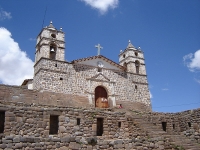
Located in Peru's central highlands and crossed by two mountain ranges, Ayacucho has much to delight history lovers. Indeed, the region is home to some of the country's most significant archaeological attractions, as well as gorgeous, pastel-coloured colonial buildings. An ancient capital city, some of the oldest pre-historic remains found in America, and richly decorated churches are all part of the destination's inheritance. Ayacucho is a relatively unknown tourism gem, though, due largely to political unrest. That is, as the capital of an isolated and traditionally poor department, it allowed Professor Abimael Guzman to foster the Sendero Luminoso (Shining Path) Maoist Revolutionary movement, causing thousands of deaths in the region during the 1980s and 1990s. Fortunately, travellers are rediscovering Ayacucho. The best time to visit is around Easter, when the city's carnival celebrations are in full swing.
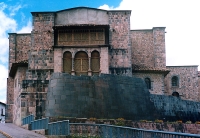
The sacred complex of Coricancha was considered the centre of the Inca world. Its name means something like 'Golden Enclosure', though Inca stonework is all that remains of the ancient Temple of the Sun. The walls and floors were once covered in sheets of solid gold, and the courtyard was filled with golden statues. Spanish reports tell of opulence that was 'fabulous beyond belief'. Spanish colonists constructed the Church of Santa Domingo on the site, destroying the temple and using its foundations for the cathedral. Major earthquakes have severely damaged the church, though the Inca stone walls still stand, and are a testament to their superb architectural skills and sophisticated stone masonry. Visitors will find an underground archaeological site museum nearby. It contains a number of interesting pieces, including mummies, textiles and sacred idols. Tourists will have the best experience if they explore the site with a guide, as good tours provide context and bring the place to life.
Address : Pampa del Castillo at Plazoleta Santo Domingo.
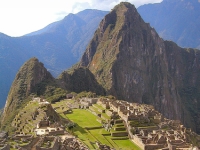
The ancient Inca citadel of Machu Picchu is regarded as the most significant archaeological site in South America, and one of the finest examples of landscape architecture in the world. It is the most enthralling of the region's citadels, and lies high in the Andes. Fortunately, Spanish colonists didn't discover and destroy the structure, as it's completely concealed from below. In fact, the western world didn't find it until an American explorer stumbled across its thickly overgrown ruins in 1911. The site is surrounded by grazing llamas and steep agricultural terraces, and consists of a central plaza, towers, palaces, water canals, ornate fountains, food storehouses, perfectly balanced archways and a sacred ceremonial area of royal tombs and intricately carved temples. The sacred Temple of the Sun is one of the site's highlights. Another is the mountain called, Huayna Picchu, which forms a dramatic backdrop to the city. All told, 'The Lost City of the Incas' has an abiding sense of majesty and mystery, despite its popularity among tourists.
Website : www.machupicchu.gob.pe
Transport : Trains leave from Cuzco and Urubamba to Aguas Calientes, where a bus transports passengers to the ruins. There is also a path leading up to the ruins from Aguas Calientes for those who prefer to walk.
Opening times : Daily 6am-5pm. Huayna Picchu closes at 3pm.
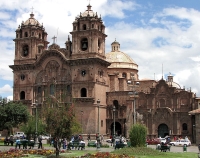
The Plaza de Armas is Cuzco's graceful main square, and is lined with colonial-style covered walkways, and houses that contain souvenir shops. Visitors will also find bars, restaurants and travel agencies. A large cathedral is the most prominent structure overlooking the square. Its elaborately carved wooden altar is covered in gold and silver plate, and its carved wooden choir stalls are regarded as Peru's finest. Cathedral visitors usually linger over The Last Supper painting, which portrays Jesus Christ and his disciples gathered around a table, which presents a platter of the local Inca delicacy, cuy (roasted guinea pig). La Compania is also on the plaza. It's one of Cuzco's most ornately decorated churches and is often floodlit at night. History lovers should make a point of walking the alleyway of Loreta, as it's lined with Incan stone walls.
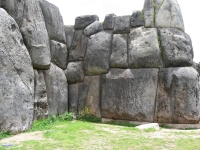
Of the four ruins near Cuzco, Sacsayhuamán is the closest and most remarkable. Spanish conquistadors used it as a quarry during their day, given its proximity to Cuzco and the dimensions of its stones. Indeed, the site provided many of the materials for the city's colonial buildings. The Spanish destroyed the original complex to such an extent that little is known about the actual purpose these magnificent buildings once served. That said, the complex is usually referred to as a fortress because of its high, impenetrable walls. Some believe it may just as easily have been a religious or ceremonial centre. The ruins cover an enormous area, but only 40 percent of the original complex remains. History lovers must visit, as the site offers a fine example of the Inca's extraordinary stone masonry. According to estimates, the complex took about 100 years to build, requiring thousands of labourers. The massive blocks of stone fit together perfectly without the aid of mortar. Each one weighs between 90 and 125 tonnes, and stands around 16ft (5m) tall.History buffs will note that the Inca and Spanish fought at the centre during the infamously bloody battle of 1536. The conflict left thousands of native people dead, providing food for circling condors. Since then, Cuzco's Coat of Arms has featured eight condors in memory of the event. Today, the site holds the annual celebrations of Cuzco's most important festival, Inti Raymi: the sun festival. Tourists should attend the colourful and spectacular affair if at all possible.
Transport : A steep 40 minute (2km) walk up from the Plaza de Armas.
Known as the Sacred Valley of the Incas, this breathtakingly beautiful and fertile valley stretches between the villages of Pisac and Ollantaytambo. Travellers will navigate it on the winding Urubamba River, with ancient Inca ruins watching from the hilltops above. The river's course also passes a sprinkling of small, traditional settlements. Visitors should note that the centrally situated Urubamba town has a decent tourist infrastructure, and is becoming a popular base from which to explore the valley. The region's most-visited sites are the citadel above Pisac and the fortress of Ollantaytambo. Culture lovers will enjoy the quaint village of Pisac, which is known for its interesting Tuesday, Thursday and Sunday morning markets. Agricultural terraces flank the steep sides of the mountain and have seen many centuries of use. Alarmingly narrow trails lie above them and lead to the cliff-hugging citadel. Visitors will find massive stone doorways and stairways cut into the rock.The road terminates at the far end of the Sacred Valley, where travellers will encounter the ancient traditional town of Ollantaytambo. Its temple-fortress clings to the nearby cliffs. Originally developed as an Inca administrative centre, the town's layout is one of the few remaining models of an Inca grid plan, and the existing town lies on the remaining Inca foundations. The ruins include the Royal Chamber, the Princess Baths and the Temple of the Sun.
Transport : Pisac is a one-hour bus journey from Cuzco. The Pisac citadel is a 30-minute walk from behind the main square or 20 minutes by taxi. Ollantaytambo is situated on the Cusco-Machu Picchu train route, or can be reached by bus with a change at Urubamba.

Travel Guide powered by Word Travels, copyright © 2023 Globe Media Ltd. By its very nature information in this travel guide is subject to change at short notice and travellers are urged to verify information on which they're relying with the relevant authorities. Neither Globe Media Ltd nor Travel Vogue can accept any responsibility for any loss or inconvenience to any person as a result of information contained above.